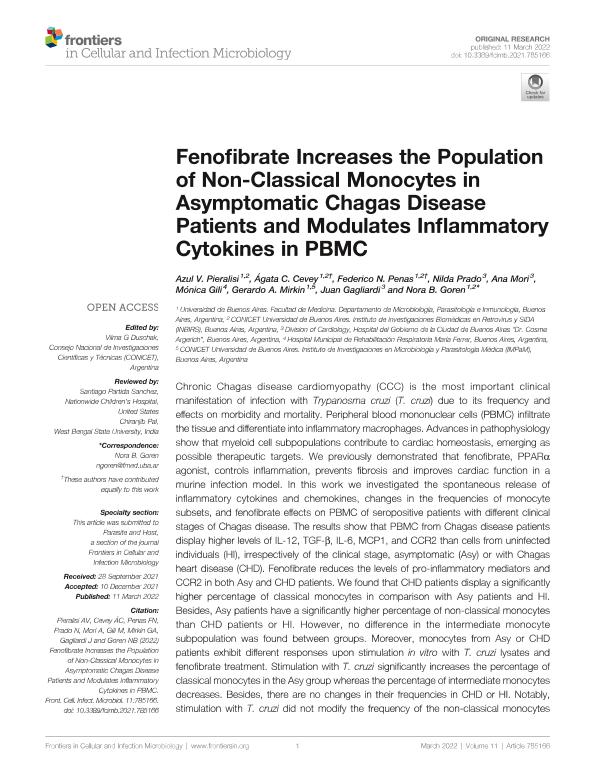Artículo
Fenofibrate increases the population of non-classical monocytes in asymptomatic Chagas disease patients and modulates inflammatory cytokines in PBMC
Pieralisi, Azul Victoria ; Cevey, Ágata Carolina
; Cevey, Ágata Carolina ; Penas, Federico Nicolás
; Penas, Federico Nicolás ; Prado, Nilda; Mori, Ana; Gili, Mónica; Mirkin, Gerardo Ariel Isidoro; Gagliardi, Juan; Goren, Nora Beatriz
; Prado, Nilda; Mori, Ana; Gili, Mónica; Mirkin, Gerardo Ariel Isidoro; Gagliardi, Juan; Goren, Nora Beatriz
 ; Cevey, Ágata Carolina
; Cevey, Ágata Carolina ; Penas, Federico Nicolás
; Penas, Federico Nicolás ; Prado, Nilda; Mori, Ana; Gili, Mónica; Mirkin, Gerardo Ariel Isidoro; Gagliardi, Juan; Goren, Nora Beatriz
; Prado, Nilda; Mori, Ana; Gili, Mónica; Mirkin, Gerardo Ariel Isidoro; Gagliardi, Juan; Goren, Nora Beatriz
Fecha de publicación:
01/2022
Editorial:
Frontiers Media
Revista:
Frontiers in Cellular and Infection Microbiology
ISSN:
2235-2988
Idioma:
Inglés
Tipo de recurso:
Artículo publicado
Clasificación temática:
Resumen
Chronic Chagas disease cardiomyopathy (CCC) is the most important clinical manifestation of infection with Trypanosma cruzi (T. cruzi) due to its frequency and effects on morbidity and mortality. Peripheral blood mononuclear cells (PBMC) infiltrate the tissue and differentiate into inflammatory macrophages. Advances in pathophysiology show that myeloid cell subpopulations contribute to cardiac homeostasis, emerging as possible therapeutic targets. We previously demonstrated that fenofibrate, PPARα agonist, controls inflammation, prevents fibrosis and improves cardiac function in a murine infection model. In this work we investigated the spontaneous release of inflammatory cytokines and chemokines, changes in the frequencies of monocyte subsets, and fenofibrate effects on PBMC of seropositive patients with different clinical stages of Chagas disease. The results show that PBMC from Chagas disease patients display higher levels of IL-12, TGF-β, IL-6, MCP1, and CCR2 than cells from uninfected individuals (HI), irrespectively of the clinical stage, asymptomatic (Asy) or with Chagas heart disease (CHD). Fenofibrate reduces the levels of pro-inflammatory mediators and CCR2 in both Asy and CHD patients. We found that CHD patients display a significantly higher percentage of classical monocytes in comparison with Asy patients and HI. Besides, Asy patients have a significantly higher percentage of non-classical monocytes than CHD patients or HI. However, no difference in the intermediate monocyte subpopulation was found between groups. Moreover, monocytes from Asy or CHD patients exhibit different responses upon stimulation in vitro with T. cruzi lysates and fenofibrate treatment. Stimulation with T. cruzi significantly increases the percentage of classical monocytes in the Asy group whereas the percentage of intermediate monocytes decreases. Besides, there are no changes in their frequencies in CHD or HI. Notably, stimulation with T. cruzi did not modify the frequency of the non-classical monocytes subpopulation in any of the groups studied. Moreover, fenofibrate treatment of T. cruzi-stimulated cells, increased the frequency of the non-classical subpopulation in Asy patients. Interestingly, fenofibrate restores CCR2 levels but does not modify HLA-DR expression in any groups. In conclusion, our results emphasize a potential role for fenofibrate as a modulator of monocyte subpopulations towards an anti-inflammatory and healing profile in different stages of chronic Chagas disease.
Palabras clave:
CHRONIC CHAGAS DISEASE
,
CYTOKINE
,
FENOFIBRATE
,
INFLAMMATION
,
MONOCYTE SUBSETS
Archivos asociados
Licencia
Identificadores
Colecciones
Articulos(IMPAM)
Articulos de INSTITUTO DE INVESTIGACIONES EN MICROBIOLOGIA Y PARASITOLOGIA MEDICA
Articulos de INSTITUTO DE INVESTIGACIONES EN MICROBIOLOGIA Y PARASITOLOGIA MEDICA
Articulos(INBIRS)
Articulos de INSTITUTO DE INVESTIGACIONES BIOMEDICAS EN RETROVIRUS Y SIDA
Articulos de INSTITUTO DE INVESTIGACIONES BIOMEDICAS EN RETROVIRUS Y SIDA
Citación
Pieralisi, Azul Victoria; Cevey, Ágata Carolina; Penas, Federico Nicolás; Prado, Nilda; Mori, Ana; et al.; Fenofibrate increases the population of non-classical monocytes in asymptomatic Chagas disease patients and modulates inflammatory cytokines in PBMC; Frontiers Media; Frontiers in Cellular and Infection Microbiology; 11; 1-2022; 1-15
Compartir
Altmétricas



